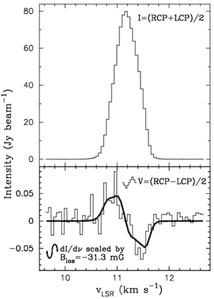
Fig. 1:— Stokes I (top: histogram) and V (bottom: histogram) profiles for the methanol maser in M8E. The curve superposed on V in the lower frame is the derivative of I scaled by a value of B = -31.3±3.5 mG.

Fig. 1:— Stokes I (top: histogram) and V (bottom: histogram) profiles for the methanol maser in M8E. The curve superposed on V in the lower frame is the derivative of I scaled by a value of B = -31.3±3.5 mG.
We report the first detection of the Zeeman effect in the 36 GHz methanol maser line. The observations were carried out with 13 EVLA antennas toward the high-mass star-forming region M8E. The Zeeman effect is usually measured by fitting the Stokes V (the difference of the right and left circular polarizations) profile to the derivative of the Stokes I (total intensity) profile, and is shown in Fig. 1. The measured magnetic field toward this source is -31.3±3.5 mG.
The Zeeman effect is the most direct method for measuring magnetic field strengths. Magnetic fields likely play an important role in the star formation process, but the exact nature of their role is still not understood; this is primarily due to the scarcity of observational data. The 36 GHz Class I methanol masers probe very early phases of star forming regions. M8E is known to be a high-mass star-forming region in a very early stage. The measured magnetic field in the 36 GHz Class I methanol maser is of the same order as the magnetic field in 6.7 GHz Class II methanol masers, for which a survey was carried out in 2008 by W. Vlemmings with the 100 m Effelsberg telescope. Class II masers also trace an early stage of star formation, but are believed to be closer to the protostellar source. The detection of the Zeeman effect in the 36 GHz methanol line by Sarma and Momjian opens up yet another window into the very early stages of a high-mass star-forming region.